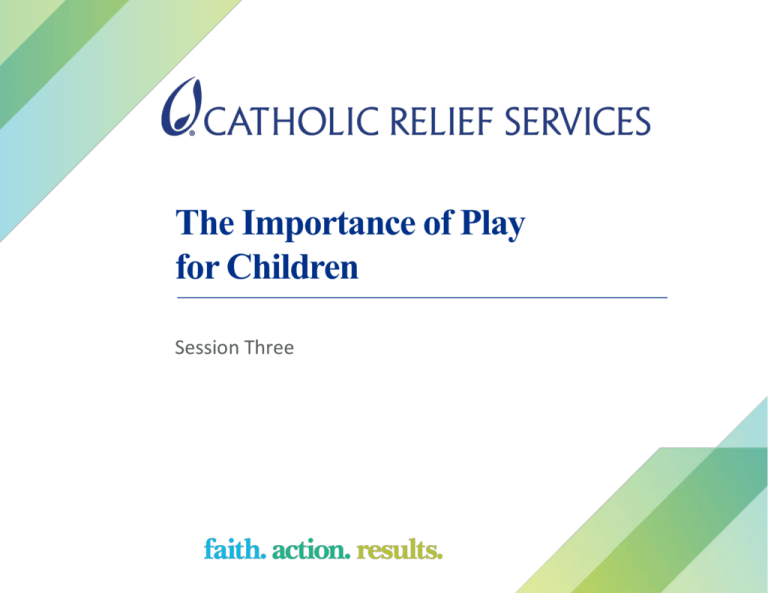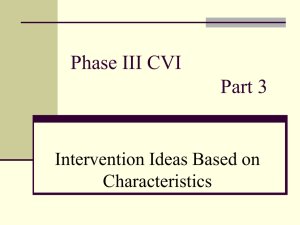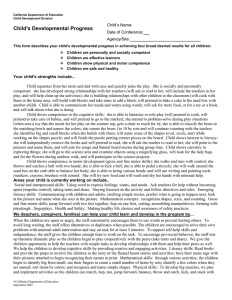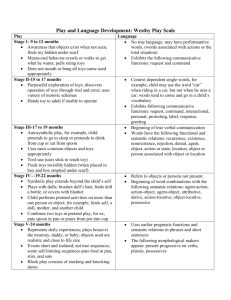The Importance of Play
advertisement

The Importance of Play for Children Session Three Baby Games • Playing with baby helps her to feel safe and loved and develop feelings of trust. o Tummy tickles o Silly songs o Blowing bubbles o Peek a boo o Lifting high in the sky o Other? Play in the Early Years The early years, especially birth through three years of age, are extremely significant in shaping the brain since "hands on" experiences cause the child to develop increasing numbers of brain synapses, or connections that shape and pattern the growing brain. Play, in the context of secure attachments to adults, gives children the enrichment, stimulation, and physical activity they need to develop their brains for future learning. (Shore, l997) Play is: • • • • A universal interdisciplinary process A self-expressive activity based on imagination. An expression of cross-cultural themes - nurturing, family relationships, roles A fundamental right of the child Remember… • Play promotes development, learning, and future success • Play activities can be created from local resources • Interaction with adults is an important part of play Children from birth to 3 years of age Language and Literacy Play involves: • Simple words, sounds and naming • Words become sentences • Interactions lead to conversational skills • Expressing needs, negotiating and sharing ideas • Responding to the language models of adults and other children Toys that Support Language and Literacy • Picture/photos—familiar people, family, pets, animals • Cloth books –sew together pieces of fabric and use non-toxic markers to make simple pictures • Puppets—make sock puppets and sew on button eyes Social and Emotional Development • Feelings of trust and acceptance allow the child to express emotions, take risks, accept disappointments, and experiment. • Non-verbal cues are as important as verbal • Children become aware of the posture, facial expression, feeling tone, and energy level of adults as they engage in play. Play that Supports Social & Emotional Development • Soft, fabric toys • A 6-7 page picture book • A set of medium size, colored light wood or plastic blocks (15-30 pieces) • Games with adults Physical Health and Motor Development Activities/things to support motor development include • Space to crawl • Pull toys • Balls, or stuffed old stockings • Riding toys • Small slides Logic and Reasoning Thinking skills are supported by: • Plastic objects • Shakers with different sounds • Stacking toys • Matching games • Sorting games • Puzzles with large pieces • Sand and water play Play Related to a Child’s Approach to Learning Opening up possibilities, creativity, divergent thinking and resilience are supported by: • Pretend and fantasy play • Things that make noise – create ‘music’ • Painting, coloring • Use of clay and play dough Assessment At this age level areas of focus are: • motor activity (fine and gross motor) • oral language and communication • social behavior • activities chosen and attention span • willingness to try new tasks, explore, and discover Children from Three to Five years of age Children from Three to Five Children are • Ready to engage in pretend, imaginative play • Able to initiate play Parents and other caregivers should • Provide space and toys • Encourage and appreciate child’s play Language and Literacy • Memory games • Lotto games • Sequence games • Storytelling • Conversation Social and Emotional Development In support of self-expression use: • Puppets • Dolls • Pretend play costumes and props • Singing, action games, movement play Physical Health and Motor Development In support of large and small motor development use: • Objects for stringing • Active play outdoors Logic and Reasoning In support of problem-solving use: • Sorting • Puzzles • Wooden or cardboard blocks Approaches Toward Learning In support of exploration use: • Art materials • Collage materials • Things to build constructions • Musical instruments Assessment Through Observation • how play is initiated • predominant themes of imaginative play • amount of time spent engaged in play activities • evidence of creativity and the imagination • use of language • physical abilities • social skills • attitude toward play Children from Six to Eight Years of Age Children from Six to Eight • In formal school setting there are explicit expectations • Able to attend to tasks for longer periods of time • Dependence on adults has decreased • Role of the peer group increased in regulating social behavior. Language and Literacy To develop language use: • Books to look through and for adults to read • Puppetry • Drama and acting out stories • Opportunities to read simple words and phrases • Opportunities to express themselves through storytelling and writing Social and Emotional Development Children in this age group: • Are interested in real-life tasks • Become competitive • Learn complex social rules Physical Health and Motor Development Physically children are more mature: • Outdoor play space is important • Equipment should challenge motor skills and encourage interactive play. • Boys and girls should be given equal opportunities with all play equipment. • Outdoor playgrounds should be clean, safe, and well supervised Physical Health and Motor Development: Outdoor Options Stationary and movable equipment • Permanent equipment includes swings, climbers • Movable equipment includes: old tires, open wooden boxes, plastic crates, bicycles, tricycles, wagons • Provision for sports (i.e., soccer, baseball, basketball) and the necessary equipment. Indoor Play Spaces Community centers and play libraries, to include: • Board games • Art and crafts materials • Pretend play costumes • Books • Clean, safe and supervised space Logic and Reasoning Children • Are capable of taking multiple perspectives • Have developed extensive memory for people and events, • Are learning about their culture and nationality as part of identity and group awareness. Toys include: • Table games • Manipulative materials Approaches Toward Learning To extend exploration and problem solving include: • Items for pretend play • Musical Instruments • Construction Materials Assessment At home and in group settings • use checklists, anecdotal records, and a weekly play journal. Children • Can reflect on their own play • Are able to keep a play portfolio- through writing and drawing









